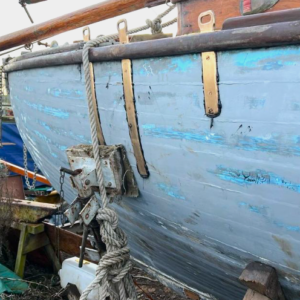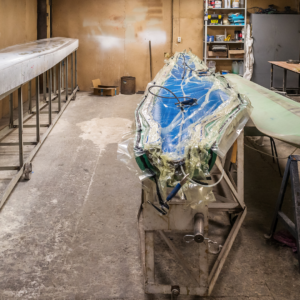How To: We asked Hamish: tell us about using peel ply?
Many of the boatbuilders featured in epoxycraft talk about using peel ply in their builds. But what is it and why is it so great? We ask our resident expert Hamish Cook to explain what it is, the benefits it offers and how best to use it.
Peel ply is often talked about by boat enthusiasts as something of a miracle fabric. This nylon cloth has been treated with a release agent, so that epoxy will not bond to it. It’s typically applied over a wet laminated surface and then peeled off when everything is cured, revealing a beautifully even surface underneath that’s ready for your next layer of epoxy. No cleaning or hours of sanding needed!
In actual fact, while the finish looks even, it’s actually textured. The fine weave of the fabric leaves behind tiny bumps and valleys in the cured epoxy and it’s these that your next layer of epoxy will adhere to.
So how do you use it? Why is it so great? Below we give you the big picture.
Using peel ply: a general guide
You typically use peel ply over the top of fibreglass cloth. Here’s the general process you’d follow.
- Apply your fibreglass to your surface with epoxy and a plastic squeegee, such as WEST SYSTEM® 808. Make sure you wet it out thoroughly.
- Lay over your peel ply and smooth it out with your squeegee.
- Once you have achieved a consistent colour surface (with no obvious air bubbles or pockets) leave it to cure. Just remember to leave a bit of peel ply at the edge of your work, which you can grab hold of later! (it is important to ensure that the peel ply is in 100% contact with the underlying epoxy surface. If there are any air pockets between the peel ply this will affect the adhesion of the next layer of epoxy).
- Once cured, simply pull the peel ply away to reveal the perfect surface for your next layer of epoxy.
The benefits
It protects the integrity of fibreglass
Using peel ply means that no sanding is needed – and that’s essential for fibreglassed surfaces. Sanding fibreglass is very challenging, primarily because you need to be careful not to damage the weave of the fabric and weaken your whole structure.
In fact, it’s arguably not possible to sand or clean a surface that’s been fibreglassed without peel ply because of the risk of amine blush being trapped in the weave of the cloth. However, peel ply eliminates this problem too (see the next point below).
It removes amine blush
Amine blush is a waxy by-product of using epoxy, which forms when the environment that the epoxy is curing in is colder or damper than it should be. It’s not typically anything to worry about as, on most surfaces, it can easily be washed away. However, this is not so easy to do on a textured fibreglass finish.
So the answer is to use peel ply. Any amine blush that forms will be on the outside of the peel ply. Once the epoxy has cured you can just remove the peel ply (taking the amine blush with it) to reveal a totally clean, amine-blush-free surface.
It’s great for repairs
Adding a layer of peel ply will also help to compact and consolidate any fibreglass repair work and helps to feather out the edges of the repair. It offers an extra layer of support to the fabric and filler materials beneath and will provide a nice even finish.
It’s great for filleting
Using a peel ply tape such as WEST SYSTEM® 872-50 or WEST SYSTEM 874-100 can save time and give a far better finish to your fillets (particularly useful with WEST SYSTEM 403 Microfibres & 405 Filleting Blend fillers). If you cut your tape into lengths, you can apply it over your fillets in overlapping strips and then just peel it away when the epoxy has cured. It helps to keep your fillet true and in place and provides a great finish, with no amine blush and far less sanding required. Once the peel ply has been removed check the surface to ensure that that the peel ply has been in 100% with the underlying surface. Any areas that appear “shiny” prepare in the normal way – wash and sand!
Just remember…
Peel ply is best on large flatter surfaces
When applied over tight curves or corners care should be taken to ensure wrinkles are not left in the peel ply which would result in wrinkles of epoxy which will take a LOT of sanding to remove.
Make sure you get the air out
Take care when applying your peel ply to smooth out any air pockets or bubbles. Any air left underneath the peel ply will allow amine blush to form affecting the adhesion of the next layer which will need plenty of sanding to smooth out.
Thanks very much to Hamish Cook for his expert knowledge and guidance.
Visit the WEST SYSTEM website to learn more about the full range of peel ply products.
Browse through the other great articles on epoxycraft.com about working with fibreglass.



